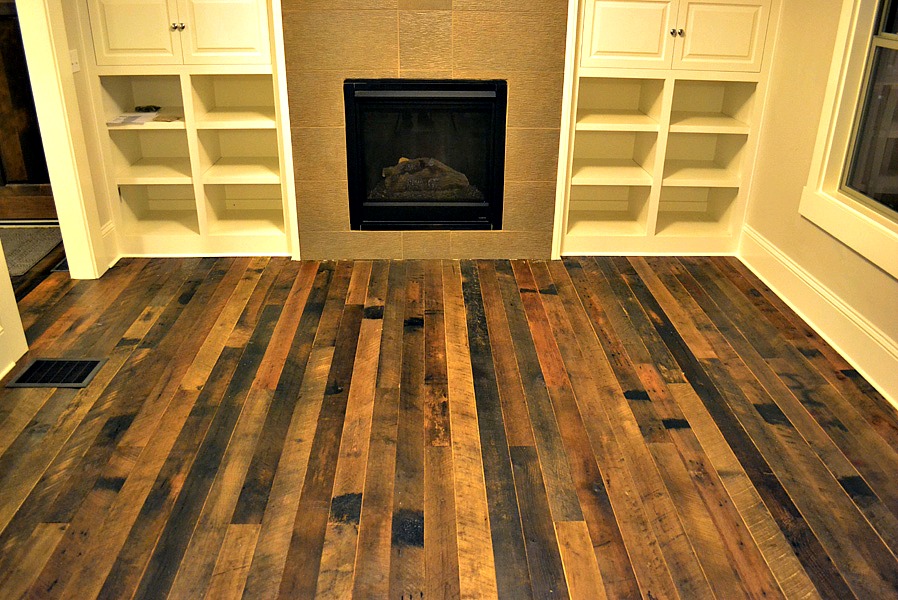Should You Use Reclaimed Wood for Your Flooring?
Friday, March 23, 2018

Reclaimed wood is all the rage these days and for good reason. Looking for something special has become rather a fool’s errand; you might think you find something unique only to find out it is a mass produced item that millions of other people have. Very few people have floors made from the wood of century old barns or factories from the 19th century. But is it practical as well as desirable?
We’re Running Our of New Lumber
One of the problems we have in the building industry is that there are less than 9 million acres of old growth trees left to harvest in the U.S. Most of those trees are on federal land and unavailable to the lumber industry. This is a great thing for conservation and the environment but not so good for the construction industry.
We use so much wood for so many purposes that you may think it’s miraculous that we have any forests left at all! About a million acres of forest are cut down annually just to make shipping pallets. Wood is still used to manufacture paper products such as newspapers, stationery, cardboard, product packaging, pencils, books, bath and facial tissue, and hundreds of other products. More than 55 million tons of wood goes to waste annually, thrown away when mistakes in manufacturing are made or people don’t recycle their paper products.
The supply of wood won’t last forever; we haven’t planted trees fast enough to replace those we’ve used over the last century. And unfortunately, no one has yet found an economically feasible alternative for most of the products, like shipping pallets, that we use on an every day basis.
The Advantages of Using Reclaimed Wood
If you’ve ever seen reclaimed wood, you’ll know it has a lot of character. Each plank is a piece of history, each board has seen generations of families do business or live within the confines of the building it comprised. Every step you take on a floor made of reclaimed wood is like sharing a part of history right there in your own home.
Reclaimed wood prevents cutting down new trees for your floor and stops the old wood from going to a landfill. Re-using one million board feet of old lumber saves one thousand acres of old growth forest!
Reclaimed lumber has been naturally weathered, sometimes for over a century, whereas new wood is forced to dry in kilns. New lumber is not nearly as dense as reclaimed wood. If you’ve ever tried to drive a nail into the wood of a house built in the 1920s you’ll know how hard wood can get as it ages. Using reclaimed wood means that old buildings are no longer just demolished but deconstructed for recycling.
The Costs of Using Reclaimed Wood
When an old building is torn down, the lumber isn’t just put directly on the market. It has to go to a mill to be prepared for re-use. The mill workers remove all the nails and screws in each board, each one is milled, kiln dried, and treated to prevent termite infestation. From there it may be refinished to fill an order or shipped out as it is to be custom finished. It take many man hours prepare reclaimed wood for other uses. All that labor is reflected in the price of the reclaimed lumber.
The quality and appearance of reclaimed wood determines the price. Most reclaimed wood comes from trees that were well over a century old when they were harvested. The more mature a tree is the more beautiful the wood it produces. Trees in our generation aren’t allowed to mature even have that time in most cases so the wood is largely unremarkable. This is another reason why reclaimed wood comes with a premium price.
Then there are the costs of laying a floor made from reclaimed lumber. The subfloor has to be just right so that moisture won’t rot the planks; it may even have to be replaced if it is being laid in an older house. You also have to add in the cost of nails, sandpaper, sealant, and skilled labor to the price of a reclaimed wood floor. Such a floor can take days to install rather than the hours it takes for a laminate floor and usually ends up costing around $10 per square foot.
An Alternative to Reclaimed Flooring
If you aren’t ready to spend a lot of money on flooring then laminate flooring might be a logical alternative. It looks like wood, it’s easy to care for, and its beauty can last as long as you live in your house.
Laminate wood is mostly imitation. It consists of a backing layer beneath high density fiberboard. Atop the fiberboard is a pattern layer protected by a plastic-like melamine layer. The pattern layer is what you see when you look at the floor; it is literally a photograph reproduced on each plank. The base of the floor is a type of wood but you are looking at what amounts to a room-sized photo!
Laminate flooring lets you have a beautiful “oak” floor for a fraction of the price. You can choose practically any type or grain of wood flooring with a fraction of the environmental impact that would be made with “real” wood. It is easy to care for and a laminate floor can be laid in less than a day.
Your Floor, Your Choice
Now that you have the facts and alternatives you can make an informed decision. You may decide not to have a wood look at all but choose durable and beautiful vinyl flooring. There are many choices to fit many styles and budgets. Your only real problem is choosing which flooring you like best!







Sorry, comments for this entry are closed at this time.